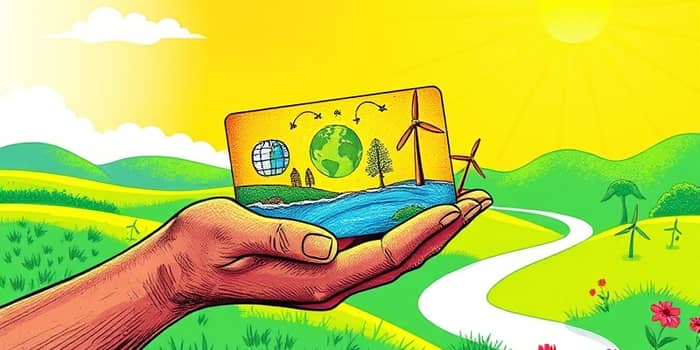Every time we swipe a credit card, we cast a vote for the kind of world we want to live in. Today’s financial products are evolving to meet the call of conscious consumers who demand that their spending habits align with their values. significantly minimize environmental impact while channeling funds toward meaningful projects is no longer a far-off dream—it’s the new frontier of consumer finance.
What Makes a Credit Card Sustainable?
Sustainable credit cards distinguish themselves through three core pillars: the materials used in production, the rewards and incentives they offer, and the environmental or social commitments of their issuers. By redefining each of these elements, banks and fintech innovators are crafting cards that are as gentle on the planet as they are rewarding to consumers.
While each material carries its own trade-offs, the shared goal is to replace traditional PVC cards with options that embody recycled PVC and reclaimed ocean plastic or even sustainably harvested wood and metal alloys. Equally important is the issuer’s stance on investments—many green card programs now avoid lending to fossil-fuel industries, ensuring that your spending power supports progress, not pollution.
How Green Cards Support Causes
Eco-conscious credit cards go beyond materials, weaving philanthropy and responsibility into every transaction. Through innovative reward structures and direct donations, these cards transform daily expenses into impactful contributions.
- Cash back or points on sustainable purchases: public transit fares, EV charging, and organic groceries.
- Automatic donations: a percentage of yearly fees or transaction volume channeled to reforestation, clean water access, or renewable energy projects.
- Carbon-offset programs: for every dollar spent, a tree planted or a share purchased in clean energy portfolios.
Such mechanisms empower cardholders to cultivate a tangible connection between their financial choices and global well-being, nurturing lasting habits of responsible consumption.
Market and Regulatory Context
The scale of conventional card production is staggering. In 2022, the financial sector produced approximately 3.5 billion cards—using enough plastic to match the weight of 95 Boeing 747s. That equates to a carbon footprint equals 288,000 passengers flying from New York to Sydney every year. This stark reality has galvanized regulators and consumers alike to demand change.
By July 2023, no fewer than 324 banks had signed the UN Principles for Responsible Banking, committing themselves to commitment to positive social impact and transparent reporting. Simultaneously, over 90% of S&P 500 companies now publish CSR reports, compared to just 20% in 2011. These shifts signal a powerful alignment between financial institutions and the planet they serve.
Consumer Impact and Behavior Change
As more green credit cards enter the marketplace, their ripple effects extend far beyond individual account statements. Incentivizing sustainable spending patterns creates a collective culture of responsibility.
- Rewarding eco-friendly purchases nudges consumers toward greener brands and services.
- Visible impact metrics—like trees planted—foster a sense of pride and accountability.
- Educational content from issuers encourages cardholders to explore deeper sustainability initiatives.
These dynamics illustrate how every swipe can serve as a micro-investment in a healthier planet, reinforcing positive habits and community engagement.
Notable Examples and Providers
The landscape of sustainable card offerings is expanding rapidly. From established banks to nimble startups, providers are racing to differentiate through purpose-driven cards:
- Thales’s eco-line: PVC-Free, Wood, Bio-Sourced, Ocean Plastic, and Recycled PVC cards with detailed lifecycle analyses.
- Fintech innovators: cards that award double points for plant-based dining and public transit expenditures.
- Community-focused programs: no annual fee cards that donate a fixed sum to local clean water or reforestation nonprofits.
These programs illustrate the diversity of approaches, yet all share a singular mission: to align spending with sustainability.
Challenges and Future Outlook
No financial product is without its hurdles. Critics argue that recycled plastics—especially ocean-recovered variants—cannot be infinitely remanufactured, ultimately ending up in landfills. Meanwhile, the overall impact of small-scale donations must be weighed against the colossal carbon footprints of entire financial institutions.
Yet even as such critiques underscore the need for holistic strategies, the momentum behind sustainable credit cards remains undeniable. Advances in circular manufacturing, combined with growing consumer demand, point toward ever-improving materials and deeper integrations with ESG commitments.
Conclusion
We stand at a pivotal moment where everyday financial tools can be powerful catalysts for change. By choosing a sustainable credit card, consumers not only reduce plastic waste and carbon emissions but also fuel projects that restore forests, empower communities, and advance renewable energy.
As this movement gains speed, each swipe becomes a testament to the belief that responsible finance and social progress are inseparable. In the quest for a more equitable and sustainable world, our wallets may prove to be among our most potent instruments of impact.
References
- https://www.nerdwallet.com/article/credit-cards/eco-friendly-credit-cards-what-do-they-promise-can-they-deliver
- https://www.nttdatapay.com/blog/eco-friendly-payment-cards/
- https://www.cnet.com/personal-finance/credit-cards/eco-friendly-credit-cards-let-you-earn-rewards-while-helping-the-environment/
- https://www.thalesgroup.com/en/markets/digital-identity-and-security/banking-payment/cards/eco-friendly-credit-card
- https://www.outlookmoney.com/banking/green-credit-cards-invest-in-eco-friendly-tomorrow-with-every-swipe
- https://online.hbs.edu/blog/post/corporate-social-responsibility-statistics
- https://www.joinatmos.com/blog/what-are-eco-friendly-debit-cards-and-credit-cards
- https://www.fec.gov/help-candidates-and-committees/foreign-nationals/










